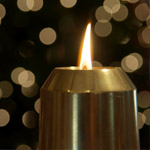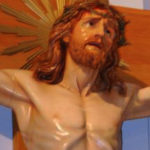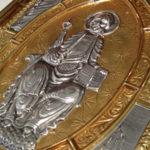The “Did You Know?” section of our site is an area where our pastoral staff provide insights into interesting aspects about our faith practices, church history and parish life.
Pentecost
 Pentecost is a greek word meaning “fiftieth.” Pentecost takes place 50 days after Easter. It is considered the birthday of the church. It celebrates the coming of the Holy Spirit upon the Apostles and their followers, and the beginning of their ministry of making disciples of all nations. At Pentecost, the Apostles were gathered in a room when a great wind blew and a flame appeared as a tongue of fire, which split itself into many individual flames above the heads of all those present. The Holy Spirit came upon them and they began to speak in tongues. Despite the fact many had no common language, they were perfectly able to understand one another. Pentecost is symbolized by depictions of the holy spirit as a dove, wind and a flame.
Pentecost is a greek word meaning “fiftieth.” Pentecost takes place 50 days after Easter. It is considered the birthday of the church. It celebrates the coming of the Holy Spirit upon the Apostles and their followers, and the beginning of their ministry of making disciples of all nations. At Pentecost, the Apostles were gathered in a room when a great wind blew and a flame appeared as a tongue of fire, which split itself into many individual flames above the heads of all those present. The Holy Spirit came upon them and they began to speak in tongues. Despite the fact many had no common language, they were perfectly able to understand one another. Pentecost is symbolized by depictions of the holy spirit as a dove, wind and a flame.Ushers
 The ministry of ushers is the oldest lay ministry in the Catholic Church. The ushers of today have descended from a long line of people of God who have gone before them. During the time of Christ, the doorkeepers of the temple numbered in the hundreds and were the forerunners of today’s ushers.
The ministry of ushers is the oldest lay ministry in the Catholic Church. The ushers of today have descended from a long line of people of God who have gone before them. During the time of Christ, the doorkeepers of the temple numbered in the hundreds and were the forerunners of today’s ushers.The more immediate predecessor of today’s usher can be found in the clerical order of porter, instituted in the 3rd Century A.D. During those times, it was the duty of the porters or ushers to guard the door of the church against any intruders who might disturb the service. The porter duties were so important that they came to be included in the rite of ordination, where they were specified as: “to ring the bells, open the church and sacristy, to open the book for the preacher.” In 1972 Pope Paul VI abolished the order of porter and this important task was given over to the laity. While today’s ushers don’t ring bells or open the church, their primary duties and responsibilities include greeting and welcoming parishioners as they enter the church, help them to find seats, taking up the collection and wishing everyone a good day at the conclusion of the Eucharistic Celebration.
Advent
 The word “Advent” comes from the Latin word, “adventus,” which means “to wait.” It is a time when we prepare to celebrate and remember Christ’s first coming in the Incarnation and also when we are reminded that we need to prepare for Christ’s second coming at the end of time. Advent is a season of waiting, conversion and hope. The use of the Advent wreath originated in the home because of the use of candles to light a room, which became even more necessary during the shorter days of Advent. The round of the wreath is a symbol of no beginning and no end, reminding us of the eternity of God. The green of the wreath symbolizes life even during the season when most plants are dead. The four candles mark the four weeks of Advent. The candles’ flame reminds us that Christ is the light of the world. The light from the wreath gets brighter with the lighting of each additional candle as we get closer to Christmas.
The word “Advent” comes from the Latin word, “adventus,” which means “to wait.” It is a time when we prepare to celebrate and remember Christ’s first coming in the Incarnation and also when we are reminded that we need to prepare for Christ’s second coming at the end of time. Advent is a season of waiting, conversion and hope. The use of the Advent wreath originated in the home because of the use of candles to light a room, which became even more necessary during the shorter days of Advent. The round of the wreath is a symbol of no beginning and no end, reminding us of the eternity of God. The green of the wreath symbolizes life even during the season when most plants are dead. The four candles mark the four weeks of Advent. The candles’ flame reminds us that Christ is the light of the world. The light from the wreath gets brighter with the lighting of each additional candle as we get closer to Christmas.
Ordinary Time
 The season of Ordinary time in the liturgical calendar of the Catholic church is anything but ordinary. This season is celebrated from the Monday following the Baptism of Our Lord up to Ash Wednesday and from Pentecost Monday to the First Sunday of Advent. This makes the season of Ordinary Time the largest season of the liturgical year. Catholics are encouraged to become extraordinary in ordinary things such as daily prayer, daily scripture readings, unite more deeply with the Lord in the Eucharist and become a more holy and whole person. Also. The readings during the liturgies of Ordinary Time help to instruct us on how to live out our Christian faith in our daily lives. Through the season of Ordinary time, the ordinary become extraordinary in Christ.
The season of Ordinary time in the liturgical calendar of the Catholic church is anything but ordinary. This season is celebrated from the Monday following the Baptism of Our Lord up to Ash Wednesday and from Pentecost Monday to the First Sunday of Advent. This makes the season of Ordinary Time the largest season of the liturgical year. Catholics are encouraged to become extraordinary in ordinary things such as daily prayer, daily scripture readings, unite more deeply with the Lord in the Eucharist and become a more holy and whole person. Also. The readings during the liturgies of Ordinary Time help to instruct us on how to live out our Christian faith in our daily lives. Through the season of Ordinary time, the ordinary become extraordinary in Christ.
The Holy Cross of Agony
 The crucifix hanging in our sanctuary is unique! It is known as the “Liimpias Corpus” (The Holy Cross of Agony). It is a duplicate of the original sculpture located at St. Peters Church in Limpias, Santander, Spain and is believed to be the work of a Spanish Sculptor Pedro de Mena (1628-1688). The difference is that most corpus have Christ looking down or the resurrected Christ. As you look at it, you will notice that His eyes are staring upward and His index and middle finger of both pierced hands are extended as though giving a final blessing. Many miracles and apparitions have been attributed to the original cross. The Crucifix that hangs in our church sanctuary dates back to the 1950’s when the new St. Gabriel church was constructed. This is truly a unique piece of our heritage here at St. Gabriel and Sacred Heart.
The crucifix hanging in our sanctuary is unique! It is known as the “Liimpias Corpus” (The Holy Cross of Agony). It is a duplicate of the original sculpture located at St. Peters Church in Limpias, Santander, Spain and is believed to be the work of a Spanish Sculptor Pedro de Mena (1628-1688). The difference is that most corpus have Christ looking down or the resurrected Christ. As you look at it, you will notice that His eyes are staring upward and His index and middle finger of both pierced hands are extended as though giving a final blessing. Many miracles and apparitions have been attributed to the original cross. The Crucifix that hangs in our church sanctuary dates back to the 1950’s when the new St. Gabriel church was constructed. This is truly a unique piece of our heritage here at St. Gabriel and Sacred Heart.
Crossing Our Forehead, Lips and Heart Before the Gospel
 After the greeting of “The Lord be with you” by the priest or deacon and our response of “And with your Spirit,” the proclaimer of the Gospel announces the reading. As the proclaimer says that, he makes the sign of the cross on the Gospel book and then makes three small crosses; one on his forehead, lips and heart. We as the congregation respond, “Glory to you, O Lord,” also making three small crosses on our forehead, lips and heart. As we sign ourselves, we silently pray that the Word of the Lord enlighten our minds (crossing the forehead), cleanse our hearts (crossing over our heart) and open our lips to proclaim His word and praise (crossing our lips). This prayer reminds us that the Word of Jesus is not to fall upon deaf ears, but rather is meant to permeate our minds, purify our speech, and change our hearts so that we can go into the world effectively witnessing to others our faith in Jesus Christ.
After the greeting of “The Lord be with you” by the priest or deacon and our response of “And with your Spirit,” the proclaimer of the Gospel announces the reading. As the proclaimer says that, he makes the sign of the cross on the Gospel book and then makes three small crosses; one on his forehead, lips and heart. We as the congregation respond, “Glory to you, O Lord,” also making three small crosses on our forehead, lips and heart. As we sign ourselves, we silently pray that the Word of the Lord enlighten our minds (crossing the forehead), cleanse our hearts (crossing over our heart) and open our lips to proclaim His word and praise (crossing our lips). This prayer reminds us that the Word of Jesus is not to fall upon deaf ears, but rather is meant to permeate our minds, purify our speech, and change our hearts so that we can go into the world effectively witnessing to others our faith in Jesus Christ.
Altar Serving
 Traditionally, the role of the altar server has always been reserved to males. It was thought that by having males serve at the altar, a young man could better be able to discern the priesthood since he is actively involved with the Liturgy serving along side the priest. It wasn’t until March of 1994 when the Vatican officially allowed females to serve as well. To serve at the altar of the Lord as an altar server is a great source of grace. The altar server assists the priest at the Sacred Liturgy. He/She has a great privilege of walking into the sanctuary during the Sacrifice of the Mass which is the Sacrifice that Jesus made and the battle over sin and death that He won at Calvary.
Traditionally, the role of the altar server has always been reserved to males. It was thought that by having males serve at the altar, a young man could better be able to discern the priesthood since he is actively involved with the Liturgy serving along side the priest. It wasn’t until March of 1994 when the Vatican officially allowed females to serve as well. To serve at the altar of the Lord as an altar server is a great source of grace. The altar server assists the priest at the Sacred Liturgy. He/She has a great privilege of walking into the sanctuary during the Sacrifice of the Mass which is the Sacrifice that Jesus made and the battle over sin and death that He won at Calvary.
The Diaconate
 The Diaconate was restored to the Church structure during Vatican Council II in the mid 1960’s. The patron saint of deacons is St. Stephen, stoned to death around 32 AD and the first disciple to be a martyr. We celebrate his feast on December 26th. Another one of our deacons to be martyred is St. Lawrence. Supposedly he was burned on a grill around 258 AD and remarked: “Turn me over I am done on this side.” We celebrate his feast on August 10th. This is also the day that deacons annually rededicate themselves and their ministry to the bishop.
The Diaconate was restored to the Church structure during Vatican Council II in the mid 1960’s. The patron saint of deacons is St. Stephen, stoned to death around 32 AD and the first disciple to be a martyr. We celebrate his feast on December 26th. Another one of our deacons to be martyred is St. Lawrence. Supposedly he was burned on a grill around 258 AD and remarked: “Turn me over I am done on this side.” We celebrate his feast on August 10th. This is also the day that deacons annually rededicate themselves and their ministry to the bishop.
